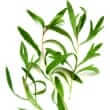Background
- Tarragon is a perennial herb of the Asteraceae family and is related to wormwood. Tarragon is widely used to flavor food. The plant's fragrant leaves give foods an anise-like flavor.
- Tarragon has a long tradition of use as a tea in the West and in Asia for treating upset stomach. It has been studied in combination with ginger and cardamom as a treatment for vomiting and nausea. Tarragon has also been studied as an herb to help manage blood sugar.
- Tarragon contains estragole, a compound which may cause liver cancer. However, the amount of estragole from short-term use of herbs and supplements in adults at recommended doses does not seem to have a high cancer risk.
References
- Cefalu WT, Ye J, Wang ZQ. Efficacy of dietary supplementation with botanicals on carbohydrate metabolism in humans. Endocr Metab Immune Disord Drug Targets 2008;8(2):78-81.
View Abstract - Chen J, Huang XF. The signal pathways in azoxymethane-induced colon cancer and preventive implications. Cancer Biol Ther 2009;8(14):1313-7.
View Abstract - Cui L, Su XZ. Discovery, mechanisms of action and combination therapy of artemisinin. Expert Rev Anti Infect Ther 2009;7(8):999-1013.
View Abstract - de Pradier E. A trial of a mixture of three essential oils in the treatment of postoperative nausea and vomiting. International Journal of Aromatherapy 2006;16(1):15-20.
- de Ridder S, van der Kooy F, Verpoorte R. Artemisia annua as a self-reliant treatment for malaria in developing countries. J Ethnopharmacol 2008;120(3):302-14.
View Abstract - Efferth T, Romero MR, Wolf DG, et al. The antiviral activities of artemisinin and artesunate. Clin Infect Dis 2008;47(6):804-11.
View Abstract - Firestone GL, Sundar SN. Anticancer activities of artemisinin and its bioactive derivatives. Expert Rev Mol Med 2009;11:e32.
View Abstract - Graziose R, Lila MA, Raskin I. Merging traditional Chinese medicine with modern drug discovery technologies to find novel drugs and functional foods. Curr Drug Discov Technol 2010;7(1):2-12.
View Abstract - Krebs S, Omer TN, Omer B. Wormwood (Artemisia absinthium) suppresses tumour necrosis factor alpha and accelerates healing in patients with Crohn's disease - A controlled clinical trial. Phytomedicine 2010;17(5):305-9.
View Abstract - Krishna S, Bustamante L, Haynes RK, Staines HM. Artemisinins: their growing importance in medicine. Trends Pharmacol Sci 2008;29(10):520-7.
View Abstract - Oreagba IA, Olayemi SO, Omotosho SK, et al. The use of artemisinin-based combination therapies (ACTs) in public secondary health facilities in Lagos, Nigeria. Niger Postgrad Med J 2008;15(2):94-100.
View Abstract - Premji ZG. Coartem: the journey to the clinic. Malar J 2009;8 Suppl 1:S3.
View Abstract - Turschner S, Efferth T. Drug resistance in Plasmodium: natural products in the fight against malaria. Mini Rev Med Chem 2009;9(2):206-2124.
View Abstract - van Wyk BE. A broad review of commercially important southern African medicinal plants. J Ethnopharmacol 2008;119(3):342-55.
View Abstract - Xu HM, Wang Y, Liu NF. Safety of an injection with a mixture of extracts from Herba Artemisiae annuae, Fructus Gardeniae and Flos Lonicerae. Pharm World Sci 2009;31(4):458-63.
View Abstract







